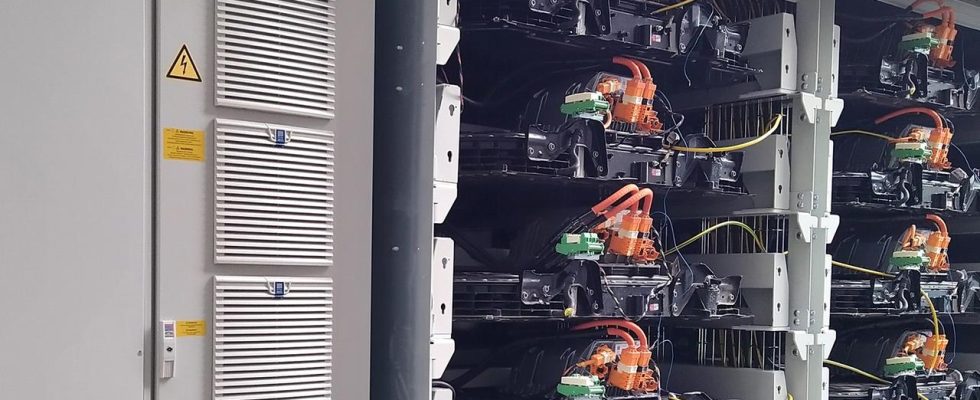Batteries of discarded e-cars are often far from exhausted. In a pilot project, they are used to store electricity from renewable energies and to compensate for grid fluctuations.
It is a pilot project by EnBW and the automobile manufacturer Audi: old electric car batteries are being replaced at the EnBW power plant site in Heilbronn second lifeas experts say – their “second life”: Many batteries are far from exhausted when they are no longer sufficient for continued operation in cars.
Instead of recycling them directly, their residual capacity can often be used more sensibly. Some batteries even survive the cars if they have to be scrapped as a total loss after an accident, or even more so if they – as in the pilot project in Heilbronn – were only used in test vehicles for a comparatively short time.
One hour of electricity for 3000 households
The old batteries are stacked in the white container on the Heilbronn power plant site and connected with plugs – six of the bulky parts on top of each other, twelve in all. Then the container is full. “The special thing about this structure is that we push the battery in here, just as it comes out of the car,” explains Alexander Kupfer, project manager for “Second Life” at Audi AG.
Connected together, the twelve batteries supply one megawatt of energy. “If you convert that to household consumption, that would correspond to around 3,000 households that are supplied with energy for one hour,” says Daniel Bahro, head of “Second Use” at EnBW.
The aim is to use the old battery containers to compensate for fluctuations in the power grid – for example by setting them up next to photovoltaic systems. When the sun is shining and there is a surplus of electricity, the high-voltage batteries could store the excess energy and use it to supply the grid on sunny days. The same applies to wind turbines on days with strong or weak winds.
Further projects planned
Up to now, there have been strong fluctuations in the German power grid – due to the weather dependency of renewable energies, increased consumption on some days or bottlenecks in the power grid. In recent months, the network operator TransnetBW has repeatedly called on consumers in Baden-Württemberg to save electricity when a lot of energy is produced by wind power in the north, but the electricity is not being transported sufficiently to the south through the ailing German network could.
The power storage could help. The project operators in Heilbronn are therefore already thinking on a larger scale. “If we have 1,000 of these containers, that’s enough to keep the frequency stable throughout Germany,” says Audi project manager Kupfer. The potential is “gigantic” – with 120,000 electric vehicles being produced at Audi this year alone.
Cooperation partner EnBW is therefore planning three more projects in the foreseeable future. Other car manufacturers also have the potential of the second life detected by batteries: in Hanover, for example, Mercedes Benz operates a system with discarded batteries from its own carsharing fleet. With a storage capacity of 17.4 megawatt hours, this battery storage system is one of the largest in Europe.
Even at home could battery storage help
Experts welcome the efforts to give old e-car batteries a second life as long as possible. “Basically, one can say that it always makes more ecological sense to use things for as long as possible. That’s also the case with batteries,” says Jürgen Sutter, who researches resources and mobility at the Öko-Institut in Darmstadt.
So far, however, the process has mainly been observed in industry. Private consumers are still rather cautious – above all because liability issues in the private sector have not yet been clarified; for example, if an old battery catches fire. In principle, however, it is conceivable that everyone at home could use a high-voltage battery to store energy, for example connected to the photovoltaic system on the roof.
Second life longer than the first
Sutter also assesses the potential of the technology as great. “Last year, 470,000 electric vehicles were registered in Germany alone,” he says. And demand will continue to rise. Other areas of application, such as the emergency power supply for hospitals, are also conceivable.
The second life of the disused car batteries could even last longer than the first life: Since the high-voltage batteries are used to store electricity with a significantly lower and more even load, they wear out much more slowly than in the car. The experts estimate that the batteries in the system could continue to live for up to ten years. Only then should they be finally recycled. Only then would they have exhausted their enormous potential.

